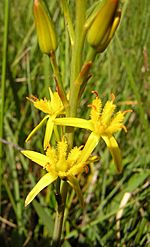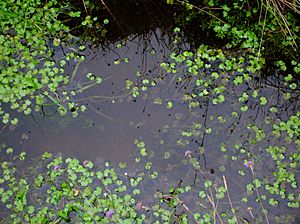Wigpool facts for kids
Wigpool is a 7.5 hectare (about 18.5 acre) nature reserve in Gloucestershire, England. It's located in the famous Forest of Dean.
This special place is looked after by two groups: the Gloucestershire Wildlife Trust and the Forestry Commission. They work together to protect the plants and animals here. They've been working together since the late 1960s, and since 2009, they've managed it as one big reserve called Wigpool. This area is very important for wildlife and is known as a Key Wildlife Site.
Contents
Discovering Wigpool Common
Wigpool Common is a special nature spot located about one mile northwest of Mitcheldean. It's surrounded by a big forest of conifer trees. Long ago, this area was mostly open bog and heathland. People have known about Wigpool Common since the late 1200s!
The reserve now has two ponds. The bigger one is the original Wigpool, and the smaller one is called Pit House Pond. Some conifer trees have been cut down recently. This helps the heathland grow back and makes the reserve much bigger.
The Landscape of Wigpool
Wigpool Common sits on a high, flat area of land. The bigger pond is in a dip in the ground. The soil here is a mix of clay and silt, which makes it acidic and peaty. This kind of soil is perfect for the unique plants that grow here.
People who live nearby have special "Commoners Rights" in the Forest of Dean. This means the area can't be fenced off.
History of the Ponds
The big Wigpool pond was drained in the 1950s when conifer trees were planted. But in 1970, volunteers helped bring it back by blocking the drainage ditches. The smaller Pit House Pond was dug much earlier, around 1840. It was made for the Wigpool Iron Mine No.1, which stopped being used in 1893.
There's also a raised bank of earth, called a bund, on the east side of the main public road. This was made by scraping off the topsoil.
Nearby Nature Spots
Wigpool Common is close to a few other important nature areas. These include Plump Hill Dolomite Quarry to the south and Hobbs Quarry to the east. Hobbs Quarry is so important that it's called a Site of Special Scientific Interest (SSSI). The Wigpool Ironstone Mine, which is also an SSSI, is right next to Wigpool Common.
Plants of Wigpool Common
Wigpool Common is home to many different kinds of plants. You can find plants that like wet, boggy areas, as well as those that prefer drier heathland or water.
Marsh and Water Plants
In the marshy areas, you might see:
- Marsh pennywort
- Lesser spearwort
- Marsh speedwell
- Common marsh bedstraw
- Floating sweet-grass
- Various types of sedge (grass-like plants)
Where the ground is a bit drier near the water, you'll find:
- Purple moor-grass
- Common bent
- Tufted hair-grass
- Different kinds of rushes
A special plant called bog asphodel grows here, and its numbers are increasing, which is great news! In the water, you might spot floating club-rush.
Heathland and Forest Plants
The reserve also has:
- Heath violet
- Heath rush
- Many types of sphagnum moss
You'll see bilberry bushes, alder trees, and grey willow trees all over the reserve. The heathland areas are home to:
- Western gorse
- Creeping willow
- Cross-leaved heath
- Bell heather
- Bramble
Open areas have also been taken over by birch trees. Sadly, sundew plants, which used to grow here, haven't been seen for many years.
Animals of Wigpool Common
This reserve is a great place for wildlife!
Birds and Amphibians
- Nesting birds like the mallard duck can be found here.
- The ponds are breeding grounds for amphibians such as the common frog, palmate newt, and smooth newt.
Insects
Many different dragonflies live around the pools, including:
- Four-spotted chaser
- Broad-bodied chaser
- Southern hawker
- Brown hawker
- Emperor dragonfly
- Common darter
- The tiny small red damselfly
Protecting Wigpool Common
Looking after Wigpool Common is important work!
Caring for the Heathland
To help the heathland grow, workers regularly cut back gorse and birch bushes using machines or by hand. This stops them from taking over the area.
Maintaining the Ponds
For the larger pond, it's important to keep the water levels high. This means making sure the dams and drains that flow into the pond are working well. They also clear away alder and willow bushes from the edges of the marsh and pond to keep the area open for other plants.
For the smaller pond, good drainage is key, and they control the clumps of purple moor-grass.
Heather Management
The heather needs to be cut regularly. This helps it grow back strong and healthy.
Exploring Wigpool Common
If you want to visit, there's a special guide that tells you about places to go for walks and where to spot wildlife in this part of the Forest of Dean.
Images for kids









